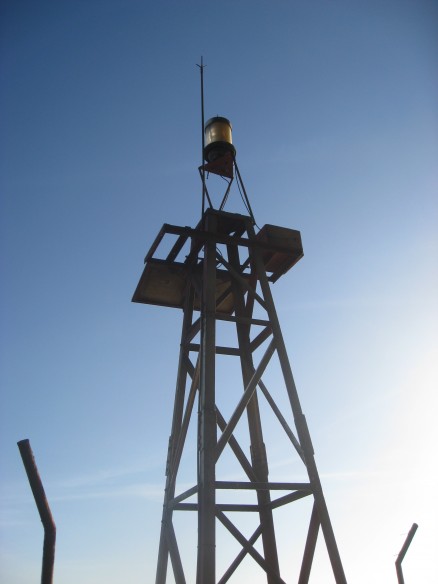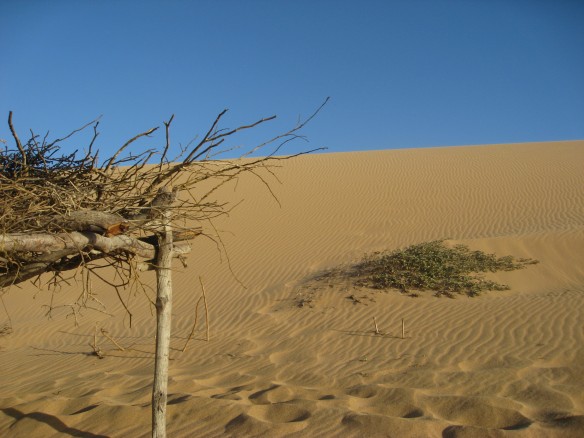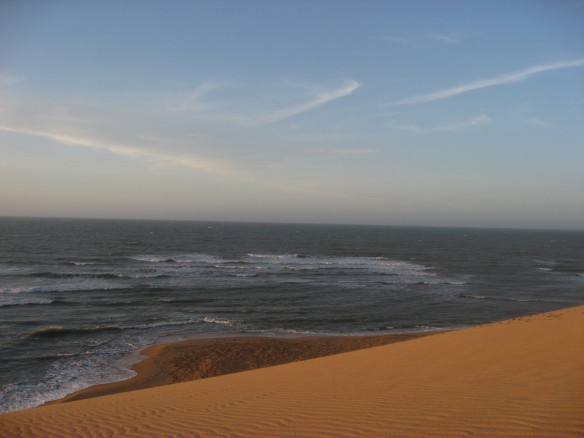A series of coves pits the coast of Colombia’s Guajira Peninsula as it arcs northward into the Caribbean Sea: the Bahía Portete, the Bahía Honda, the Bahía Hondita. From the ground, these bays are chasms eaten into granular earth, wind-sculpted hollows of shallow and azure blue, sketches in miniature for the Gulf of Venezuela’s wide and lyrical sweep. A lonely lighthouse marks the land’s terminal point, where sand sighs at last into rolling sea, and then the continent turns south and falls away into the Gulf, to Maicao and Maracaibo and the perpetual bustle of cross-border trade. This lighthouse, the Faro Punta Gallinas, is skeletal and corroded, 18 metres of red-and-white stripes fading gradually to orange in the salt air. There’s an old concrete hut at its base, presumably once a light keeper’s shelter, but long neglected now. The face that looks out to sea is painted yellow and patterned with black letters, giving the occasional tourist a sign to be photographed against: Punta Gallias es el punto mas norte de Colombia y America del sur. The wind here is sonorous and alien as it shapes the dunes into tall and temporary mountains, and beyond the empty doorframe, small replicas made of sand and dirt form and reform in the corners of the hut’s only room. A diet cola can skitters across the floor, animated by a momentary draft, and it falls quiet again.
I arrived in Punta Gallinas from Cartagena, a Spanish colonial city whose lighthouses are stone-clad and towering. I had not intended to travel so far north, but some weeks before, in one of the innumerable cafés of Bogotá’s student district, I’d met a writer who had sold me the magic of La Guajira. We drank dark coffees together in the twilight hours before the unspoken curfew when the capital’s streets become menacing, and I’d left the city planning my route into the wilderness. It takes time to head north; first to Cartagena, then through Barranquilla and Santa Marta, and finally to Riohacha, the last refuge of Marquez’s marauding anti-heroes.
Each step is marked by a sense of growing resistance; the language becomes thick and fast, receding into costeño slur, and the rivers that slice through the land every few kilometres in the south become gradually further apart, fruit plantations giving way to arid plains. Riohacha itself rises in a pastiche of majesty from the desert; Highway 90 turns at a right angle here to head to the Venezuelan border, and the city seems stranded betwixt the desert and the coast. Its buildings are draped in the colours of the multinational corporations who dig coal from the surrounding earth in open pits. There is work to be had here, and on the pavements the men awaiting dispatch to the Cerrejón mine sit in clusters, eating barbequed goat and drinking sickly orange Colombiana.
The battered Lonely Planet I’d picked up in a second-hand bookstore in Bogotá gave a romanticised vision of Riohacha’s sea front. The promised long pier is metal skeleton and eroded board, but I walked down it and sat in the vivid and dying light of day, looking back to the town. The waterfront is dotted with decommissioned cannons, black specks on the beach telling of a military history that still animates the town’s collective imagination. There is a long story of resistance here: the Spanish colonisers pushed the native Arawak Indians north in founding the city, and then fought English pirates like Francis Drake, whose military cacophony is remembered in Marquez’s One Hundred Years of Solitude:
When the pirate Sir Francis Drake attacked Riohacha in the sixteenth century, Úrsula Iguarán’s great-great-grandmother became so frightened with the ringing of alarm bells and the firing of cannons that she lost control of her nerves and sat down on a lighted stove.
By the early 19th century Riohacha was fighting for independence from the Spanish, and the port served as a meeting point for Bolívar’s vessels as they congregated for battle in Caribbean waters. The state of ‘Gran Colombia’ that was forged from this fight has long since fragmented; Venezuela, Guyana, Peru, Brazil, Ecuador, and Colombia stand separately, this first great symbol of independent Latin America now obsolete. I met Andrés, the writer from the city, by one of these old cannons on the promenade next to the pier. He was leaning against the warm and black metal, reading from a ripped chapbook of poems written in a Spanish I did not understand. He said we would head north in the morning.
We went to Manuare first, by colectivo from Riohacha’s central plaza. Here, seawater rushes up great pipes to shallow sunlit pools, the residual salt then stacked in crystalline mountains. The mine is my first encounter with the indigenous Wayúu, who comb the peaks and shovel this white gold onto waiting trucks in oppressive heat. The dialect has thickened still, and the men call to one another in a rapid pattern of speech, Wayúu words studding the discourse; sense recedes into sound, rise and fall, staccato and song. Salt sticks to the back of my legs and to my neck and dries and tightens there, removed only by fingernails pulled closely over skin. It is dry and hot here, and we are keen to leave, so we take a ride north with one of the many export drivers plying the trade route to Uribia. He smokes through the half-open window as we bounce across compacted mud roads, and a couple of hours later leaves us by a square where men and women trade all manner of goods, frenetically swapping battered US dollars for the day’s offerings, fish from the sea and second-hand clothing from the south. We try to find a driver heading further north as the stalls close and the marketplace quiets, but we cannot, and so we eat late in a shop selling cheap almuerzos under a shaded canopy. The owner is amused at our predicament; why head north, he asks, when Uribia is an isolated paradise? You cannot have a refrigerated soda in the desert. He laughs and retires, but returns presently with a suggestion: los ecoturistas.
Ecotourism has exploded in La Guajira over the past five years, and surely enough, as the afternoon heat dissipates, great convoys of 4x4s emerge from the desert and spill their cargo of Europeans and North Americans into the town. These trucks head up and down the peninsula, through Cabo de la Vela and up to the Bahía Honda and Punta Gallinas, a three-day visit to the end of the world. It is by far the easiest way to travel further north: not far from Uribia, the paved highway disappears and is replaced by tracks crossing bare mud. Earth that is hard and compacted in the dry season becomes waterlogged sponge during the twice-annual rains, when the land becomes gloriously and briefly green. The vehicles traverse this land effortlessly, stopping in the desert for gasolina that has been smuggled over the Venezuelan border in two-litre plastic drinks bottles. This petrol is siphoned into tanks by young men who take alternate drags on cigarettes and plastic tubing, never seeming to care about the risk that shadows each lungful. Some hours and refuelling stops later, we arrive for the night at Cabo de la Vela, and take a hammock each in a thatched open shelter just off the dirt road. We are metres from the sea, which is cool and still in this rocky inlet, though the darkening evening is still relentlessly warm. Dinner is langostino, the local lobster, served barbequed on the beach with fried plantain and bottles of imported Tabasco. It grows darker as we eat, and silence falls with the night, punctured only by the irregular cough of a motorbike engine from somewhere within the blackness.
We come across some Wayúu people the next morning, travelling still further north in the back of a different truck. A thin steel chain is strung between two trees, and a small girl emerges from a little house built in a clearing some 20 metres away. She holds a platter in one hand and a soda bottle of yellow fuel in the other, and calls langostinos? gasolina? as she approaches. The driver passes her a boiled sweet when she unties the rope crossing her checkpoint, and it is difficult not to think how this motorised transport has changed life here, the ease of travel across the shifting desertlands standing in stark contrast to Guajira’s historic patterns of settlement. The land itself has resisted its settlers and its colonisers in both pure and political senses. It is not easy to live in a wind-swept desert, to eke out a living from an angry sea and inhospitable earth. The Wayúus have succeeded by farming goats from remote and distant family rancherias, never forming larger towns or settlements, always moving animals to new ground. Their resistance is written into their language, which is spattered with harsh ‘W’ sounds, inarticulable to the Spanish tongue. These are rendered as the softer ‘gu’ on maps and in administrative papers, Guajira arising from Wayúu in transliteration. Though the scenery does not change, the land becomes unfamiliar, quietly different as modern Colombia recedes to the south.
Punta Gallinas itself is a land of ghosts, and by the time we approach in the evening, the sky is the colour of green mud. Here on this northern precipice of the continent, the earth and sea and sky are as one, punctuated, as the wind rallies and the night wears on, by lone stars in the celestial canopy. This is the mythical land that has resisted us, and it is a strange and sad place. The faro that stands nearby might evoke some romantic and stone-based fantasy in name, but in presence it reduces the word to a rudimentary literalism implied only in English translation: it is the house of a light, built to warn the ships that sail the South American trade routes of impending shallows and rocky ledges.1 The continent here seems to gather its last energy to sigh resignedly into the waters; there is none of the ice and fire of the south’s angular and jagged taper, just a shrug, a collapse waterward.
The next morning, we take a boat across the Bahía Honda. I am decidedly tired, and Andrés is quietly engaged with this most mellifluous of landscapes. The water is a sulphurous blue, and it laps rusted hulls and the breasts of bobbing birds as it mixes with tangled weeds and the wind’s sorry song. We hitch another ride to the south, taking a different track this time, and find a paved road within the hour, soon joined by a railroad with mile-long cargo trains ferrying resources back and forth. It feels like we have imported want into this landscape in our 4x4s as luggage, but this is no Latin pastoral. The Wayúus’ societal longevity comes from an ability to adapt, and this they continue to do, making money from the convoys of both people and commodities that snake, daily, up and down the backbone of the cape. By night we are in Riohacha, our journey at an end, and we part at a dusty junction on the north-south road. Here in civilisation, the desert retreats quickly into memory, mythologised in fleeting binaries: sharp fuel on salt air, hard wind on soft grain. I return, lost in thought, to Tayrona, where the ground regains its energy and the Sierra Nevada rises aggressively and steeply from a more passionate sea.
1 Faro is the Spanish for lighthouse, the word taken from the Greek through Latin. It is thought that the Romans referred to the Lighthouse at Alexandria by the name of the man who built it, the King of Egypt, or Pharaoh.



To comment on an article in The Junket, please write to comment@thejunket.org; all comments will be considered for publication on the letters page of the subsequent issue.